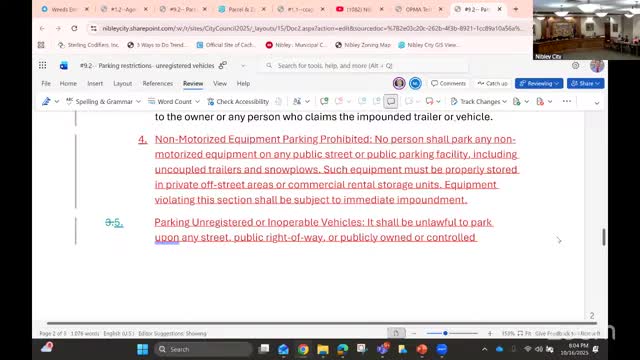Council weighs clearer rules for weeds, right‑of‑way visibility and fire hazard
October 17, 2025 | Nibley , Cache County, Utah
This article was created by AI summarizing key points discussed. AI makes mistakes, so for full details and context, please refer to the video of the full meeting. Please report any errors so we can fix them. Report an error »

Nibley City staff brought an information item Oct. 16 seeking direction on the city’s weed and overgrowth ordinance after residents and code staff flagged multiple complaints about tall roadside vegetation.
Staff said the current ordinance is vague and hard to enforce because it lacks specific height thresholds. The county handles state‑listed noxious weeds, but city code covers other uncultivated grass, brush and vegetation; staff said enforcement has typically occurred only where vegetation creates a fire hazard, blocks sidewalks or obstructs corner visibility.
Council and residents discussed competing goals: neighborhood appearance, pedestrian clearances on park strips and sidewalks, fire hazard reduction and protecting native plantings and designated natural areas. Staff suggested a practical approach: define a modest height threshold (several communities use 4–6 inches for maintained turf near sidewalks), require a cleared buffer adjacent to sidewalks and intersections for visibility, and keep exemptions for active agricultural production while allowing the city to insist on trimmed edges within a roadway buffer.
Council asked staff to prepare draft ordinance language for a future meeting that would: (1) set enforceable height or buffer standards for rights of way and park strips where pedestrian or vehicle sightlines are affected, (2) preserve native plant and designated open‑space areas from arbitrary enforcement, and (3) describe the notice, removal and billing process when the city must abate hazards.
No vote was taken; council asked staff to return with model language and suggested specific buffer distances and height thresholds for consideration.
Staff said the current ordinance is vague and hard to enforce because it lacks specific height thresholds. The county handles state‑listed noxious weeds, but city code covers other uncultivated grass, brush and vegetation; staff said enforcement has typically occurred only where vegetation creates a fire hazard, blocks sidewalks or obstructs corner visibility.
Council and residents discussed competing goals: neighborhood appearance, pedestrian clearances on park strips and sidewalks, fire hazard reduction and protecting native plantings and designated natural areas. Staff suggested a practical approach: define a modest height threshold (several communities use 4–6 inches for maintained turf near sidewalks), require a cleared buffer adjacent to sidewalks and intersections for visibility, and keep exemptions for active agricultural production while allowing the city to insist on trimmed edges within a roadway buffer.
Council asked staff to prepare draft ordinance language for a future meeting that would: (1) set enforceable height or buffer standards for rights of way and park strips where pedestrian or vehicle sightlines are affected, (2) preserve native plant and designated open‑space areas from arbitrary enforcement, and (3) describe the notice, removal and billing process when the city must abate hazards.
No vote was taken; council asked staff to return with model language and suggested specific buffer distances and height thresholds for consideration.
View the Full Meeting & All Its Details
This article offers just a summary. Unlock complete video, transcripts, and insights as a Founder Member.
✓
Watch full, unedited meeting videos
✓
Search every word spoken in unlimited transcripts
✓
AI summaries & real-time alerts (all government levels)
✓
Permanent access to expanding government content
30-day money-back guarantee


